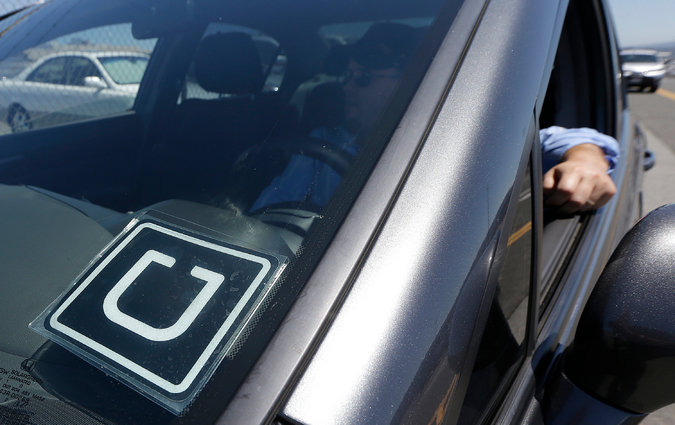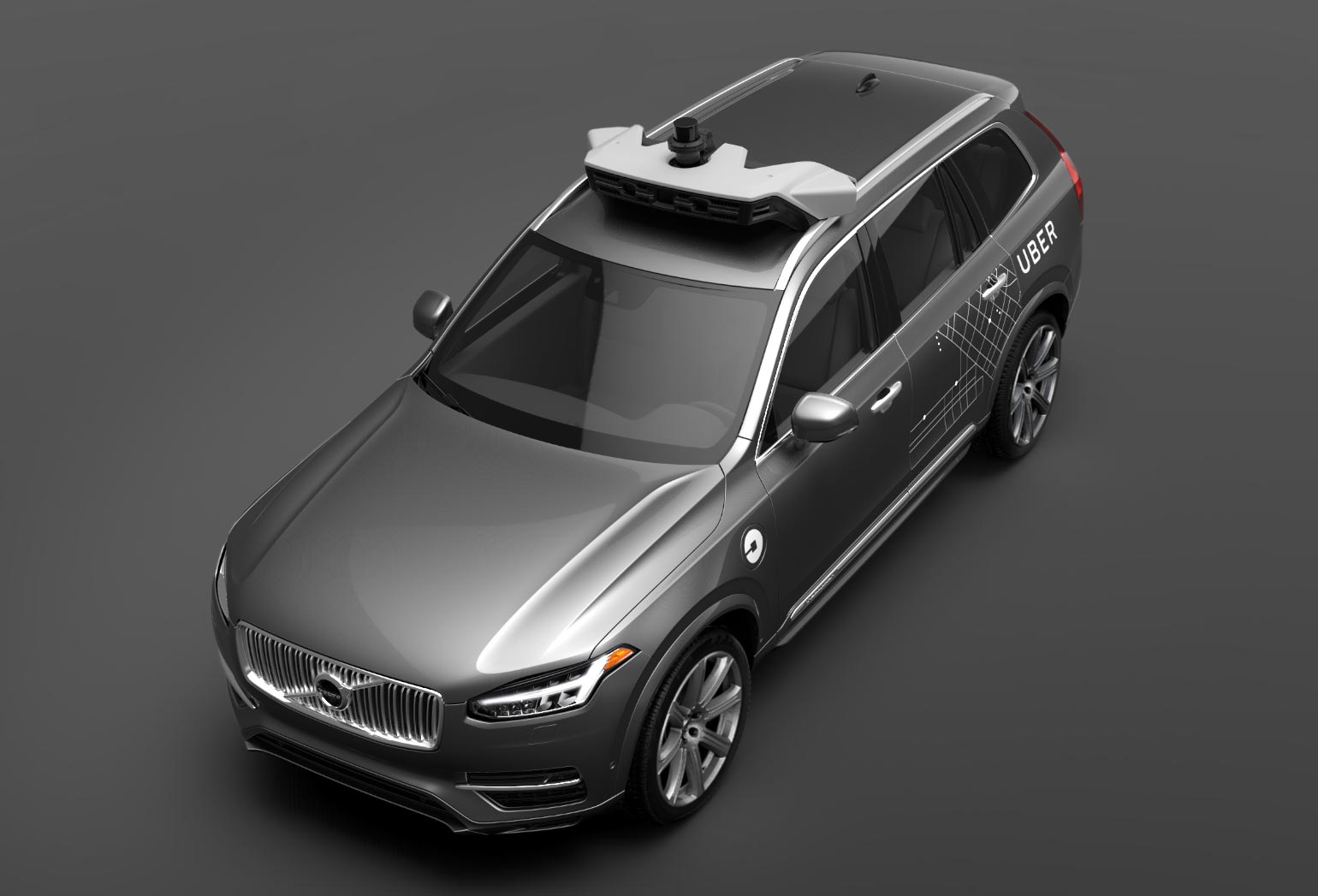News
Uber will offer self-driving Volvos in Pittsburgh this month

Uber customers in Pittsburgh who request a ride from the ride sharing service may find themselves riding in a specially prepared Volvo XC90 that can drive itself. Passengers will ride in a self-driving vehicle chaperoned by a human driver behind the wheel ready to take control of the car if necessary and an engineer monitoring the operation of the autonomous system. This will mark the first time a self-driving car has been used in commercial service in the United States.
Uber’s self-driving car program has been under the stewardship of John Bares since January, 2015. Bares was head of Carnegie Mellon University’s National Robotics Engineering Center for 13 years before he left to start Carnegie Robotics, a Pittsburgh-based company that makes components for self-driving industrial robots used in mining, farming, and the military.
“I turned him [Kalanick] down three times. But the case was pretty compelling.” Bares says. Once he joined Uber, he quickly put together a team consisting of hundreds of engineers, robotics experts, and few old fashioned auto mechanics. The mission was nothing less that to replace Uber’s 1 million human drivers with robotic drivers as soon as possible. The message is, if you drive for Uber, you should keep your resumé up to date and your eyes open for other lines of work.
Pittsburgh is the center of the Uber self-driving experiment because that is where the talent is. Carnegie Mellon is a world leader in autonomous systems. Its graduates are working on the Google car and are in high demand at any company planning to offer self-driving cars, including Apple and Tesla. Earlier in the year, a Tesla Model S loaded with cameras and sensors, presumably a test mule for Autopilot 2.0, was spotted testing in Pittsburgh.
So far, Uber has just a few specially modified Volvo XC90s ready for commercial service, but it expects to have 100 of them by the end of the year. The hardware at the heart of its self-driving system includes cameras, radar, lidar, GPS receivers, and a liquid cooled computer mounted in the rear.
Uber is moving fast. “We are going commercial,” says CEO Travis Kalanick. “This can’t just be about science.” Last month, it purchased Otto, a start-up company that is working to bring self-driving long haul trucks to market. In theory, its technology will allow truck drivers to crawl in back and nap while the trucks are on the highway. Uber will take over and re-brand that business and incorporate the Otto technology into its own self-driving systems.
Otto’s founders were all previously members of the Google car program, but grew impatient with the slow, plodding pace of development at Google. They wanted an opportunity to showcase their talents much sooner than they could if they remained at Google. “We were really excited about building something that could be launched early,” says Anthony Levandowski, co-founder of Otto.
Kalanick is clearly looking to be the first to begin offering a self-driving ride hailing service. He intends to beat Tesla, Apple, Google, Ford, and Genera Motors to the punch. “Nobody has set up software that can reliably drive a car safely without a human,” he says in an oblique reference to Tesla’s Autopilot system. “We are focusing on that.” Developing an autonomous vehicle, he adds, “is basically existential for us.”
At first, trips in the self-driving Volvos will be free. Uber’s standard local rate is $1.30 per mile but Kalanick says eventually prices will be so low that the cost per mile will be cheaper in a self-driving Uber than in a private car, even in rural areas. “That could be seen as a threat,” says Volvo CEO Hakan Samuelsson. “We see it as an opportunity.”
Source: Bloomberg Photo credit: Uber, AP

News
Tesla FSD fleet is nearing 7 billion total miles, including 2.5 billion city miles
As can be seen on Tesla’s official FSD webpage, vehicles equipped with the system have now navigated over 6.99 billion miles.

Tesla’s Full Self-Driving (Supervised) fleet is closing in on almost 7 billion total miles driven, as per data posted by the company on its official FSD webpage.
These figures hint at the massive scale of data fueling Tesla’s rapid FSD improvements, which have been quite notable as of late.
FSD mileage milestones
As can be seen on Tesla’s official FSD webpage, vehicles equipped with the system have now navigated over 6.99 billion miles. Tesla owner and avid FSD tester Whole Mars Catalog also shared a screenshot indicating that from the nearly 7 billion miles traveled by the FSD fleet, more than 2.5 billion miles were driven inside cities.
City miles are particularly valuable for complex urban scenarios like unprotected turns, pedestrian interactions, and traffic lights. This is also the difference-maker for FSD, as only complex solutions, such as Waymo’s self-driving taxis, operate similarly on inner-city streets. And even then, incidents such as the San Francisco blackouts have proven challenging for sensor-rich vehicles like Waymos.
Tesla’s data edge
Tesla has a number of advantages in the autonomous vehicle sector, one of which is the size of its fleet and the number of vehicles training FSD on real-world roads. Tesla’s nearly 7 billion FSD miles then allow the company to roll out updates that make its vehicles behave like they are being driven by experienced drivers, even if they are operating on their own.
So notable are Tesla’s improvements to FSD that NVIDIA Director of Robotics Jim Fan, after experiencing FSD v14, noted that the system is the first AI that passes what he described as a “Physical Turing Test.”
“Despite knowing exactly how robot learning works, I still find it magical watching the steering wheel turn by itself. First it feels surreal, next it becomes routine. Then, like the smartphone, taking it away actively hurts. This is how humanity gets rewired and glued to god-like technologies,” Fan wrote in a post on X.
News
Tesla starts showing how FSD will change lives in Europe
Local officials tested the system on narrow country roads and were impressed by FSD’s smooth, human-like driving, with some calling the service a game-changer for everyday life in areas that are far from urban centers.

Tesla has launched Europe’s first public shuttle service using Full Self-Driving (Supervised) in the rural Eifelkreis Bitburg-Prüm region of Germany, demonstrating how the technology can restore independence and mobility for people who struggle with limited transport options.
Local officials tested the system on narrow country roads and were impressed by FSD’s smooth, human-like driving, with some calling the service a game-changer for everyday life in areas that are far from urban centers.
Officials see real impact on rural residents
Arzfeld Mayor Johannes Kuhl and District Administrator Andreas Kruppert personally tested the Tesla shuttle service. This allowed them to see just how well FSD navigated winding lanes and rural roads confidently. Kruppert said, “Autonomous driving sounds like science fiction to many, but we simply see here that it works totally well in rural regions too.” Kuhl, for his part, also noted that FSD “feels like a very experienced driver.”
The pilot complements the area’s “Citizen Bus” program, which provides on-demand rides for elderly residents who can no longer drive themselves. Tesla Europe shared a video of a demonstration of the service, highlighting how FSD gives people their freedom back, even in places where public transport is not as prevalent.
What the Ministry for Economic Affairs and Transport says
Rhineland-Palatinate’s Minister Daniela Schmitt supported the project, praising the collaboration that made this “first of its kind in Europe” possible. As per the ministry, the rural rollout for the service shows FSD’s potential beyond major cities, and it delivers tangible benefits like grocery runs, doctor visits, and social connections for isolated residents.
“Reliable and flexible mobility is especially vital in rural areas. With the launch of a shuttle service using self-driving vehicles (FSD supervised) by Tesla in the Eifelkreis Bitburg-Prüm, an innovative pilot project is now getting underway that complements local community bus services. It is the first project of its kind in Europe.
“The result is a real gain for rural mobility: greater accessibility, more flexibility and tangible benefits for everyday life. A strong signal for innovation, cooperation and future-oriented mobility beyond urban centers,” the ministry wrote in a LinkedIn post.
News
Tesla China quietly posts Robotaxi-related job listing
Tesla China is currently seeking a Low Voltage Electrical Engineer to work on circuit board design for the company’s autonomous vehicles.

Tesla has posted a new job listing in Shanghai explicitly tied to its Robotaxi program, fueling speculation that the company is preparing to launch its dedicated autonomous ride-hailing service in China.
As noted in the listing, Tesla China is currently seeking a Low Voltage Electrical Engineer to work on circuit board design for the company’s autonomous vehicles.
Robotaxi-specific role
The listing, which was shared on social media platform X by industry watcher @tslaming, suggested that Tesla China is looking to fill the role urgently. The job listing itself specifically mentions that the person hired for the role will be working on the Low Voltage Hardware team, which would design the circuit boards that would serve as the nervous system of the Robotaxi.
Key tasks for the role, as indicated in the job listing, include collaboration with PCB layout, firmware, mechanical, program management, and validation teams, among other responsibilities. The role is based in Shanghai.
China Robotaxi launch
China represents a massive potential market for robotaxis, with its dense urban centers and supportive policies in select cities. Tesla has limited permission to roll out FSD in the country, though despite this, its vehicles have been hailed as among the best in the market when it comes to autonomous features. So far, at least, it appears that China supports Tesla’s FSD and Robotaxi rollout.
This was hinted at in November, when Tesla brought the Cybercab to the 8th China International Import Expo (CIIE) in Shanghai, marking the first time that the autonomous two-seater was brought to the Asia-Pacific region. The vehicle, despite not having a release date in China, received a significant amount of interest among the event’s attendees.









